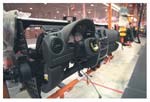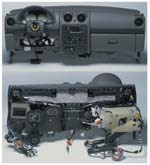
The line at the JCI Northwood plant consists of 27 stations separated into four zones. The line is laid out so that there is accessibility to both sides of the assembly.

The cockpit assembly built by Johnson Controls for the 2002 Jeep Liberty.
Previous
Next
Related:
Automotive Electronics
Automotive Supply Side
Related Suppliers
-
Johnson Controls
When you were a kid (or, if you are a major executive that shops at one of those stores that provides clever desk knick-knacks) you probably had a Slinky®. As Bruce MacLachlan, plant manager, Johnson Controls’ facility in Northwood, Ohio, puts it, “We’re managing a big Slinky.”
No, Johnson Controls (JCI) hasn’t gotten into the toy business. No, the Northwood plant doesn’t make seat springs.
The analogy is actually of a system that stretches 9.5 miles, from the loading dock at Northwood to the line-side at the DaimlerChrysler Toledo North Assembly Plant (TNAP), home of the new Jeep Liberty. (OK, since we gave it to Slinky: that’s Jeep® Liberty.) And just as when you pull a Slinky at one end there is an effect on the other, that’s precisely the case between TNAP and JCI Northwood: When TNAP broadcasts an order, there is a 204-minute window. Boing!
What they are building at Northwood are cockpits for the Liberty. This is JCI’s first “major initiative” in cockpits, according to Bob Jensen, VP and GM of Cockpit, Overhead, Door, and Cargo Systems—Product and Business Development. And he stresses: “This is not just Johnson Controls. This was a Johnson Controls and DaimlerChrysler product development.” And there were an additional 35 suppliers working with JCI on the initial team for the development of the cockpit.
What Is It?
Traditionally, say “cockpit” and someone thinks “airplane.” Maybe it has something to do with the fact that the instrumentation in automotive vehicles smack of avionics, but the word is now becoming part of the vocabulary of automotive interiors.
Ron Hemmeke, manager, Business Development & Product Planning, Instrument Panels & Floor Consoles, explains that while there may be a good deal of fuzziness with regard to the precise definition of automotive “cockpit,” a good rule of thumb is to figure that it is an instrument panel and subsystems. Things, he acknowledges, get a little tricky in that there is another term that’s finding frequency: “IP module.” Precisely where that ends and the cockpit begins is a subject that will probably not be fully understood until sometime around 2008—that’s when the folks at JCI see cockpits being the number-1 area of project work, with IP modules and IPs following behind.
On a macro level, a cockpit can be considered to consist of six major elements:
- Electrical distribution
- Safety
- First surface and trim
- HVAC system
- User interface
- Vehicle control
In the precise case of the Liberty, there are:
- The injection molded IP (said to be the first-ever of its type to carry content, as in the steering column, HVAC and pedals)
- IP trim
- Structural duct
- HVAC system
- Steering column
- Pedal system
- Airbag system
- Cluster
- Audio system
- Junction block
- IP wire harness
- Body wire harness
All of these elements are assembled, tested, and shipped, in sequence, to the DCX plant. Jensen says, “We have responsibility for the entire assembly,” adding, “Functional responsibility.” When you are build-ing in sequence, you’ve got to be certain that what you’re building for your customer works.
Rationalizing Cockpits.
During the development process, the original concept called for an IP, not a cockpit. But as the development went on, for a variety of reasons, things became more integrated. The co-located team dealt with issues including cost, timing, feasibility, packaging, and logistics. Although there were various components that DCX selected to be used in the Liberty cockpit (e.g., airbag, pedals, steering column, cluster, HVAC, radio), Jensen suggests that as other cockpit programs follow, it is likely that the percentage of the components selected by the OEM will go down and the supplier’s responsibility will increase.
The reason for increased supplier responsibility is fairly easy to understand. Consider JCI and the move toward more comprehensive responsibility. Its Automotive Systems Group had year 2000 sales of $12.7-billion; it is delivering interior systems for 23 million 2001 model year vehicles. Although it is involved in battery and power management systems, its major focus is on seating, IPs, overhead components and systems, floor consoles and storage systems, door systems, electronics, and cargo management. All of which is to say that JCI has strong capability and competence in interiors.
OEMs are continuing to outsource manufacturing and assembly operations. Outsourcing design and development activities is a further extension of that. Among the reasons that OEMs may find this attractive are capital reductions for development, financial risk reduction, and access to technology. Among the reasons why the suppliers may find this attractive are that it represents opportunities for more business.
Making It.
According to MacLachlan, when the cockpit was being developed, a manufacturing engineer was part of the team. Assembly and logistics were kept in mind. When there is a 60-second takt time, keeping those things in mind is important.
The 128,000-ft2 Northwood facility was specifically constructed to handle the requirements of Liberty. As MacLachlan describes it, “We developed the layout of the line and then capped it with a building.” The line consists of 27 stations. There is accessibility on both sides of the line in order to accommodate assembling on either side of the cockpit. There are two colors and both right-hand and left-hand steering models produced. MacLachlan notes that “on paper” there is somewhere on the order of 40,000 different combinations that can be assembled (think of the various audio systems and other options that can be added or subtracted); the 250 to 500 range is what they are more likely to see in the Northwood plant. Although there is part commonality for the two versions and the ability to symmetrically attach the parts on either side of the thermoplastic IP, because of the need to have quality build assurance of all cockpits, there is extensive use of barcodes on the parts. Not only do the barcodes (and the scanning of same) provide assurance that the proper parts are attached to the proper cockpit-in-becoming, but the DC-driven torque guns are setup so that the fasteners are inserted with the appropriate torque. (This is especially key for the safety-critical fasteners.)
One hundred percent of the cockpits are tested before they leave the plant. Because it takes five minutes for testing, and because there is a one-minute takt time on the line, there are six test stands. The finished cockpits are loaded into the semi-trailer as they are built; a two-tiered truck conveyor system is used to load the cockpits. One load is 40 cockpits. Once the trailer arrives at TNAP, there is automatic unload.








